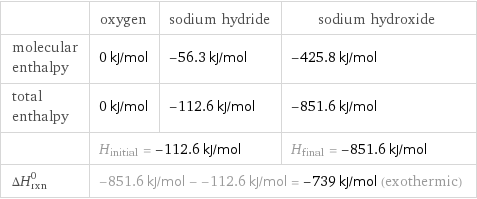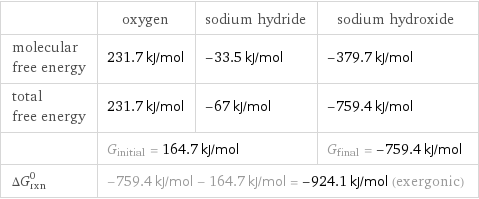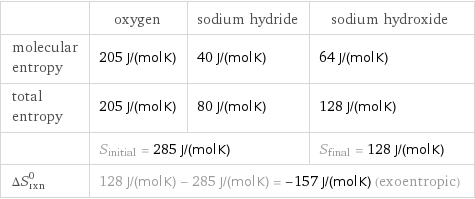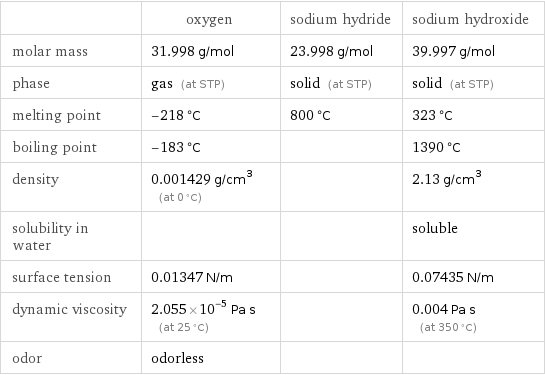Input interpretation

O_2 oxygen + NaH sodium hydride ⟶ NaOH sodium hydroxide
Balanced equation

Balance the chemical equation algebraically: O_2 + NaH ⟶ NaOH Add stoichiometric coefficients, c_i, to the reactants and products: c_1 O_2 + c_2 NaH ⟶ c_3 NaOH Set the number of atoms in the reactants equal to the number of atoms in the products for O, H and Na: O: | 2 c_1 = c_3 H: | c_2 = c_3 Na: | c_2 = c_3 Since the coefficients are relative quantities and underdetermined, choose a coefficient to set arbitrarily. To keep the coefficients small, the arbitrary value is ordinarily one. For instance, set c_1 = 1 and solve the system of equations for the remaining coefficients: c_1 = 1 c_2 = 2 c_3 = 2 Substitute the coefficients into the chemical reaction to obtain the balanced equation: Answer: | | O_2 + 2 NaH ⟶ 2 NaOH
Structures

+ ⟶
Names

oxygen + sodium hydride ⟶ sodium hydroxide
Reaction thermodynamics
Enthalpy

| oxygen | sodium hydride | sodium hydroxide molecular enthalpy | 0 kJ/mol | -56.3 kJ/mol | -425.8 kJ/mol total enthalpy | 0 kJ/mol | -112.6 kJ/mol | -851.6 kJ/mol | H_initial = -112.6 kJ/mol | | H_final = -851.6 kJ/mol ΔH_rxn^0 | -851.6 kJ/mol - -112.6 kJ/mol = -739 kJ/mol (exothermic) | |
Gibbs free energy

| oxygen | sodium hydride | sodium hydroxide molecular free energy | 231.7 kJ/mol | -33.5 kJ/mol | -379.7 kJ/mol total free energy | 231.7 kJ/mol | -67 kJ/mol | -759.4 kJ/mol | G_initial = 164.7 kJ/mol | | G_final = -759.4 kJ/mol ΔG_rxn^0 | -759.4 kJ/mol - 164.7 kJ/mol = -924.1 kJ/mol (exergonic) | |
Entropy

| oxygen | sodium hydride | sodium hydroxide molecular entropy | 205 J/(mol K) | 40 J/(mol K) | 64 J/(mol K) total entropy | 205 J/(mol K) | 80 J/(mol K) | 128 J/(mol K) | S_initial = 285 J/(mol K) | | S_final = 128 J/(mol K) ΔS_rxn^0 | 128 J/(mol K) - 285 J/(mol K) = -157 J/(mol K) (exoentropic) | |
Equilibrium constant
![Construct the equilibrium constant, K, expression for: O_2 + NaH ⟶ NaOH Plan: • Balance the chemical equation. • Determine the stoichiometric numbers. • Assemble the activity expression for each chemical species. • Use the activity expressions to build the equilibrium constant expression. Write the balanced chemical equation: O_2 + 2 NaH ⟶ 2 NaOH Assign stoichiometric numbers, ν_i, using the stoichiometric coefficients, c_i, from the balanced chemical equation in the following manner: ν_i = -c_i for reactants and ν_i = c_i for products: chemical species | c_i | ν_i O_2 | 1 | -1 NaH | 2 | -2 NaOH | 2 | 2 Assemble the activity expressions accounting for the state of matter and ν_i: chemical species | c_i | ν_i | activity expression O_2 | 1 | -1 | ([O2])^(-1) NaH | 2 | -2 | ([NaH])^(-2) NaOH | 2 | 2 | ([NaOH])^2 The equilibrium constant symbol in the concentration basis is: K_c Mulitply the activity expressions to arrive at the K_c expression: Answer: | | K_c = ([O2])^(-1) ([NaH])^(-2) ([NaOH])^2 = ([NaOH])^2/([O2] ([NaH])^2)](../image_source/30654faf49ac98394f396b79cc87623e.png)
Construct the equilibrium constant, K, expression for: O_2 + NaH ⟶ NaOH Plan: • Balance the chemical equation. • Determine the stoichiometric numbers. • Assemble the activity expression for each chemical species. • Use the activity expressions to build the equilibrium constant expression. Write the balanced chemical equation: O_2 + 2 NaH ⟶ 2 NaOH Assign stoichiometric numbers, ν_i, using the stoichiometric coefficients, c_i, from the balanced chemical equation in the following manner: ν_i = -c_i for reactants and ν_i = c_i for products: chemical species | c_i | ν_i O_2 | 1 | -1 NaH | 2 | -2 NaOH | 2 | 2 Assemble the activity expressions accounting for the state of matter and ν_i: chemical species | c_i | ν_i | activity expression O_2 | 1 | -1 | ([O2])^(-1) NaH | 2 | -2 | ([NaH])^(-2) NaOH | 2 | 2 | ([NaOH])^2 The equilibrium constant symbol in the concentration basis is: K_c Mulitply the activity expressions to arrive at the K_c expression: Answer: | | K_c = ([O2])^(-1) ([NaH])^(-2) ([NaOH])^2 = ([NaOH])^2/([O2] ([NaH])^2)
Rate of reaction
![Construct the rate of reaction expression for: O_2 + NaH ⟶ NaOH Plan: • Balance the chemical equation. • Determine the stoichiometric numbers. • Assemble the rate term for each chemical species. • Write the rate of reaction expression. Write the balanced chemical equation: O_2 + 2 NaH ⟶ 2 NaOH Assign stoichiometric numbers, ν_i, using the stoichiometric coefficients, c_i, from the balanced chemical equation in the following manner: ν_i = -c_i for reactants and ν_i = c_i for products: chemical species | c_i | ν_i O_2 | 1 | -1 NaH | 2 | -2 NaOH | 2 | 2 The rate term for each chemical species, B_i, is 1/ν_i(Δ[B_i])/(Δt) where [B_i] is the amount concentration and t is time: chemical species | c_i | ν_i | rate term O_2 | 1 | -1 | -(Δ[O2])/(Δt) NaH | 2 | -2 | -1/2 (Δ[NaH])/(Δt) NaOH | 2 | 2 | 1/2 (Δ[NaOH])/(Δt) (for infinitesimal rate of change, replace Δ with d) Set the rate terms equal to each other to arrive at the rate expression: Answer: | | rate = -(Δ[O2])/(Δt) = -1/2 (Δ[NaH])/(Δt) = 1/2 (Δ[NaOH])/(Δt) (assuming constant volume and no accumulation of intermediates or side products)](../image_source/af4a1e0be582ad5076f15f29377249f2.png)
Construct the rate of reaction expression for: O_2 + NaH ⟶ NaOH Plan: • Balance the chemical equation. • Determine the stoichiometric numbers. • Assemble the rate term for each chemical species. • Write the rate of reaction expression. Write the balanced chemical equation: O_2 + 2 NaH ⟶ 2 NaOH Assign stoichiometric numbers, ν_i, using the stoichiometric coefficients, c_i, from the balanced chemical equation in the following manner: ν_i = -c_i for reactants and ν_i = c_i for products: chemical species | c_i | ν_i O_2 | 1 | -1 NaH | 2 | -2 NaOH | 2 | 2 The rate term for each chemical species, B_i, is 1/ν_i(Δ[B_i])/(Δt) where [B_i] is the amount concentration and t is time: chemical species | c_i | ν_i | rate term O_2 | 1 | -1 | -(Δ[O2])/(Δt) NaH | 2 | -2 | -1/2 (Δ[NaH])/(Δt) NaOH | 2 | 2 | 1/2 (Δ[NaOH])/(Δt) (for infinitesimal rate of change, replace Δ with d) Set the rate terms equal to each other to arrive at the rate expression: Answer: | | rate = -(Δ[O2])/(Δt) = -1/2 (Δ[NaH])/(Δt) = 1/2 (Δ[NaOH])/(Δt) (assuming constant volume and no accumulation of intermediates or side products)
Chemical names and formulas

| oxygen | sodium hydride | sodium hydroxide formula | O_2 | NaH | NaOH Hill formula | O_2 | HNa | HNaO name | oxygen | sodium hydride | sodium hydroxide IUPAC name | molecular oxygen | sodium hydride | sodium hydroxide
Substance properties

| oxygen | sodium hydride | sodium hydroxide molar mass | 31.998 g/mol | 23.998 g/mol | 39.997 g/mol phase | gas (at STP) | solid (at STP) | solid (at STP) melting point | -218 °C | 800 °C | 323 °C boiling point | -183 °C | | 1390 °C density | 0.001429 g/cm^3 (at 0 °C) | | 2.13 g/cm^3 solubility in water | | | soluble surface tension | 0.01347 N/m | | 0.07435 N/m dynamic viscosity | 2.055×10^-5 Pa s (at 25 °C) | | 0.004 Pa s (at 350 °C) odor | odorless | |
Units
